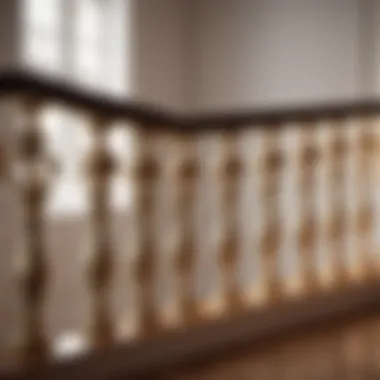Materials:
- 20 feet of stainless steel railing
- 15 stainless steel railing posts (36 inches each)
- 1 gallon of marine-grade stainless steel cleaner and polish
- Installation hardware kit (including screws and anchors)
DIY Steps:
- Measure and Plan: Start by measuring the length of the railing area and determining the spacing for the posts. Consider safety regulations for height requirements.
- Preparation: Clean the installation area thoroughly with the stainless steel cleaner to ensure a smooth surface for mounting.
- Positioning Posts: Mark the positions for each post according to your spacing plan and secure them using the installation hardware provided.
Technical Aspects:
- Tools Required: Drill, measuring tape, level, screwdriver
- Timing Specifics: Allocate a full day for the installation process
- Critical Techniques: Ensure posts are aligned correctly and securely anchored to support weight
DIY Project Process:


- Attach Railing: Begin by positioning and securing the railing along the installed posts, ensuring it is level and securely fastened.
- Finishing Touches: Clean any smudges or fingerprints with the stainless steel cleaner and polish to enhance the railing's appearance.
Troubleshooting Tips:


- If posts are not aligning properly, double-check measurements and adjust as needed
- For wobbly railing, reinforce with additional anchors or supports
Introduction


In the realm of home improvement, the installation of a railing stands as a fundamental task, enhancing both safety measures and the overall aesthetic appeal of a space. This comprehensive guide aims to delve into the intricate process of railing installation, from the initial considerations to the final touches. By understanding the importance of railing installation, homeowners can embark on this journey with confidence and precision, ensuring a seamless and rewarding outcome.
Understanding the Importance of Railing Installation
-
Enhancing Safety Measures:
Safety is paramount when it comes to home structures like railings. The essence of enhancing safety measures through quality railing installation cannot be overstated. From preventing accidental falls to providing reliable support, a well-installed railing ensures the safety of occupants and adds a layer of security to any elevated surface. The durability and stability of the railing components play a vital role in safeguarding individuals, making it a crucial aspect of this installation process.
-
Aesthetic Value:
Beyond its practical function, a railing contributes significantly to the visual appeal of a space. The aesthetic value of a well-crafted railing lies in its ability to elevate the overall design scheme of a property. Whether opting for sleek modern lines or traditional embellishments, the design of the railing can enhance the architectural charm and harmonize with the existing decor. Balancing safety with aesthetics, homeowners can achieve a seamless integration of style and functionality through thoughtful railing installation.
-
Regulatory Compliance:
Compliance with building codes and regulations is a pivotal consideration in any home improvement project, including railing installation. Adhering to regulatory requirements ensures that the railing meets the necessary standards for safety and structural integrity. By following these guidelines, homeowners can avoid potential liabilities and legal implications, guaranteeing a compliant and secure railing installation within their property.
Key Considerations Before Installation
-
Material Selection:
Choosing the right materials for the railing is a critical decision that impacts both its aesthetic appeal and durability. From classic wood to contemporary metal options, each material brings its unique characteristics to the forefront. Considering factors such as weather resistance, maintenance requirements, and cost-effectiveness can aid homeowners in selecting the most suitable material for their railing installation project.
-
Design Choices:
The design of the railing plays a significant role in defining the style and ambiance of a space. Whether opting for a minimalist glass railing or a ornate wrought iron design, the choice of design shapes the overall look and feel of the property. Striking a balance between functionality and visual appeal, homeowners can explore various design options to find the perfect fit for their home.
-
Budget Planning:
Effective budget planning is essential for a successful railing installation project. Determining the overall cost of materials, labor, and additional expenses upfront can prevent unexpected financial burdens during the installation process. By setting a realistic budget and identifying cost-saving opportunities, homeowners can ensure a smooth and financially viable railing installation experience.
Preparation Stage
In the realm of installing a railing, the preparation stage stands as a pivotal phase that sets the foundation for a successful project. This crucial phase cannot be overstated, as it dictates the entire trajectory of the installation process. Proper preparation ensures that the project progresses smoothly, adheres to safety protocols, and results in a visually appealing and structurally sound railing.
The Preparation Stage covers key elements such as gathering necessary tools and materials, measuring and planning the installation, and checking local building codes. Each of these components plays a crucial role in the overall success of the railing installation, making it imperative to approach the preparation stage with attention to detail and precision.
Gathering Necessary Tools and Materials
When embarking on a railing installation project, one of the primary steps is to assemble the essential tools and materials required for the task at hand. A comprehensive understanding of the tools checklist and materials checklist is essential for a seamless installation process.
Tools Checklist
The tools checklist comprises fundamental items like measuring tape, level, screwdriver, hammer, drill, safety goggles, and gloves. Each tool serves a specific purpose in the installation process, from taking accurate measurements to securing components in place. Having a well-curated tools checklist ensures efficiency, accuracy, and safety throughout the installation.
Materials Checklist
Equally significant is the materials checklist, which includes railing sections, balusters, post brackets, base plates, screws, and anchor bolts. Selecting high-quality materials is paramount for the durability and aesthetic appeal of the railing. The materials checklist offers a comprehensive overview of all components needed for a sturdy and visually pleasing end result.
Measuring and Planning the Installation
Accurate measurements and meticulous planning are the bedrock of a successful railing installation. Precision in measurement ensures that the railing fits seamlessly within the designated space, while strategic planning maps out the layout and design scheme effectively.
Taking Accurate Measurements
Taking accurate measurements involves assessing the dimensions of the installation area with precision. This step is critical in determining the exact placement of the railing components, ensuring a cohesive and secure fit. Accurate measurements eliminate errors and prevent discrepancies during the installation process.
Planning the Layout
Planning the layout involves envisioning the placement of the railing, balusters, and other components within the space. Consideration of design aesthetics, functionality, and compliance with building codes underpins the planning phase. A thoughtfully planned layout enhances the visual appeal of the railing while maintaining structural integrity.
Checking Local Building Codes
Navigating local building codes is a necessary part of the preparation stage to ensure regulatory compliance and safety standards are met. Adhering to relevant regulations and permit requirements is essential to avoid complications during the installation process and post-completion.
Understanding Regulations
Understanding the regulations set forth by local authorities is fundamental in guaranteeing a compliant railing installation. Regulations may dictate railing height, spacing between balusters, and material requirements to ensure safety standards are upheld. Knowledge of these regulations is key to a successful and legally sound railing project.
Permit Requirements
Obtaining the necessary permits for the railing installation is a critical step in aligning with local building codes. Permit requirements vary based on location and the scope of the project, and failure to secure permits can result in fines or project delays. Adhering to permit regulations ensures a smooth and hassle-free installation process.
This in-depth look at the preparation stage underscores its significance in the overall railing installation process, emphasizing the meticulous attention to detail and planning required for a successful outcome.
Installation Process
In the process of installing a railing, the Installation Process section holds paramount importance in this comprehensive guide. The meticulous execution of each step ensures a secure and aesthetically pleasing railing system for your space. This section delves into specific elements that are crucial to the successful completion of the railing installation, offering insights into essential considerations that will guide you through the process.
Setting Up the Railing Base
Attaching Post Brackets
Attaching post brackets is a fundamental aspect of establishing a sturdy foundation for your railing. By securely fastening the post brackets to the underlying surface, you create a robust anchor point for the entire railing system. The key characteristic of post brackets lies in their ability to provide structural support and stability, essential for ensuring the safety and longevity of the railing. Their popularity stems from the reliability they offer in keeping the railing upright and secure. One unique feature of post brackets is their versatility in accommodating various railing designs and materials. While they excel in providing structural integrity, one disadvantage may lie in the visibility of the brackets, which may impact the visual aesthetics of the railing.
Securing Base Plates
Securing base plates acts as another crucial step in the railing installation process. Base plates serve as the interface between the railing base and the surface it is attached to, distributing the load evenly and enhancing the stability of the railing system. The key characteristic of base plates is their ability to provide a secure connection while allowing for minor adjustments during installation. Their popularity is attributed to the ease of installation and the added reinforcement they offer to the railing structure. One unique feature of base plates is their compatibility with various surfaces and materials, making them a versatile choice for different railing configurations. However, a potential disadvantage could be the exposed look of base plates, affecting the overall visual appeal of the railing.
Installing the Railing Sections
To continue the installation process, the next step involves attaching the railing sections. This phase is crucial in determining the overall look and functionality of the railing. Attaching railings involves securing the horizontal components that run along the length of the structure, offering support and a defining visual element to the railing system. The key characteristic of railings is their role in providing safety by preventing falls and defining the boundary of the space. Their popularity lies in the range of design options available, allowing for customization to suit various aesthetics and preferences. A unique feature of railings is their versatility in accommodating different materials and styles, offering flexibility in design possibilities. While railings enhance both safety and aesthetics, a potential disadvantage could be the need for regular maintenance to ensure their longevity.
Securing Balusters
Securing balusters is a crucial aspect that complements the railing sections, contributing to the overall stability and visual appeal of the structure. Balusters are vertical pillars or spindles that fill the space between the railings, providing additional support and decorative detailing to the railing system. The key characteristic of balusters is their role in enhancing safety by preventing objects or individuals from slipping through the gaps. Their popularity stems from the ornamental value they add to the railing, enhancing the overall design aesthetic. A unique feature of balusters is their customizable options in terms of materials, shapes, and patterns, allowing for personalization in the railing design. However, a potential disadvantage could be the intricate maintenance required to keep balusters clean and intact.
Securing the Railing System
The final stage of securing the railing system involves critical assessments to ensure its stability and longevity. Checking the stability of the railing system involves verifying the integrity of each component and the overall structure to withstand environmental factors and usage over time. The key characteristic of stability checks is their ability to detect any weak points or issues that may compromise the safety of the railing. Their popularity lies in the peace of mind they offer, knowing that the railing is secure and reliable for everyday use. One unique feature of stability checks is their preventive nature, allowing for early detection and rectification of potential problems. However, a potential disadvantage could be the time-consuming nature of thorough stability assessments.
Using Fasteners
Utilizing fasteners is an essential aspect of securing the railing system in place, providing the necessary connections between components to ensure structural integrity. Fasteners play a pivotal role in keeping the railing stable under various stresses, such as wind loads or sudden impacts. The key characteristic of fasteners is their strength and durability, essential for withstanding environmental factors and maintaining the railing's integrity over time. Their popularity comes from the reliable fastening they offer, ensuring that the railing remains secure in place. A unique feature of fasteners is their variety of types and sizes to accommodate different railing materials and installation requirements. While fasteners are instrumental in ensuring the stability of the railing system, a potential disadvantage could be the occasional need for maintenance to prevent rust or looseness.
These detailed sections provide a comprehensive insight into the intricacies of installing a railing, emphasizing the importance of each step and component in creating a safe, functional, and visually appealing addition to your space.
Finishing Touches
In this final stage of the railing installation process, the focus shifts to the crucial
Conclusion
In the realm of installing a railing, the conclusion phase marks the culmination of a meticulous process aimed at not only enhancing the aesthetic appeal of your space but also prioritizing safety, compliance, and functionality. As individuals who have undertaken this enriching journey, reaching the conclusion stage brings a sense of achievement and satisfaction that goes beyond mere physical completion.
Throughout this detailed guide to installing a railing, the significance of the conclusion stage cannot be overstated. Embracing the final checks and maintenance tips is crucial in ensuring the longevity and performance of your newly installed railing. By conscientiously following quality assurance checks and engaging in regular maintenance practices, you not only uphold the integrity of your railing system but also guarantee its continued efficiency over time.
Final Checks and Maintenance Tips
Quality Assurance Checks
Quality assurance checks in the context of railing installation hold paramount importance in guaranteeing the structural integrity and safety of the completed project. These checks involve thorough inspections of every component, verifying adherence to established guidelines and standards. By meticulously assessing the workmanship and materials, quality assurance checks serve as a safeguard against potential issues that could compromise the functionality and durability of the railing.
A key characteristic of quality assurance checks lies in their ability to identify any deviations from the planned installation process, ensuring that corrections are made promptly to rectify any shortcomings. This meticulous approach eliminates errors early on, contributing significantly to the overall success of the railing installation. While these checks may entail additional time investment, the benefits of enhanced safety and longevity far outweigh the temporary inconvenience, making them an indispensable practice in this article.
Regular Maintenance Practices
Regular maintenance practices are the cornerstone of preserving the pristine condition of your railing beyond the installation phase. By establishing a routine maintenance schedule that includes cleaning, inspections, and minor repairs, homeowners can prolong the lifespan of their railing while upholding its visual appeal. These practices not only contribute to the aesthetic enjoyment of the railing but also ensure its continued functionality in the face of wear and tear.
The key characteristic of regular maintenance practices is their preventive nature, preempting potential issues before they escalate into costly repairs. By conducting regular inspections and addressing minor issues promptly, homeowners can avoid extensive damage and prolong the longevity of their railing system. While regular maintenance requires ongoing commitment, the advantages of a well-maintained railing – including safety, visual appeal, and cost-effectiveness – justify the time and effort expended in this essential upkeep.
Admiring the Completed Railing
Amidst the practical aspects of railing installation, taking a moment to admire the completed railing adds a touch of satisfaction and pride to the homeowner's heart. The finished look of a well-installed railing not only enhances the visual aesthetics of the space but also serves as a testament to the dedication and precision invested in the installation process. Enjoying the finished look encompasses a sense of fulfillment derived from transforming a vision into a tangible, functional reality.
Enjoying the Finished Look
Admiring the finished look of your railing involves appreciating the seamless integration of design, craftsmanship, and functionality. The key characteristic of this aspect lies in the visual cohesion and harmony achieved through a carefully executed installation, where every detail contributes to the overall appeal of the railing system. By taking a moment to relish the sight of your completed project, homeowners can bask in the satisfaction of a job well done, knowing that their attention to detail has paid off.
Sharing Your Success
Sharing your success in installing a railing extends beyond personal gratification to inspiring others contemplating a similar project. The key characteristic of this aspect lies in the ability to showcase your achievement, serving as a source of motivation and encouragement for fellow homeowners embarking on their railing installation journey. By sharing your success story, you not only celebrate your accomplishment but also contribute to a community of individuals passionate about elevating their living spaces with elegant and functional railings.





